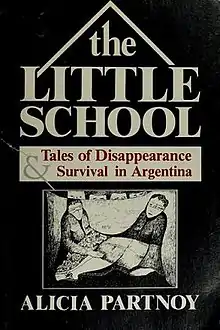 First edition | |
| Author | Alicia Partnoy |
|---|---|
| Country | Argentina |
| Language | English |
| Genre | Novel |
| Publisher | Midnight Editions |
Publication date | 1986 |
| Pages | 136 |
| ISBN | 1-57344-029-9 |
| OCLC | 40178370 |
The Little School[1][2] is a novel written by Alicia Partnoy,[3] a woman who was "disappeared" during the Dirty War[4] period of the history of Argentina.[5] It is an account of a clandestine detention center.[6] She tells of all the people that she met and saw through a tiny hole in her blindfold.[7] The guards made sure prisoners of The Little School did not talk with each other or see each other.[8] Prisoners were beaten and tortured for almost any reason and many were killed.[9]
Military regimes are not at all unusual in Argentina, but those that ruled from 1976 to 1979[10] were unique in the number of civilians, mostly young people, who were kidnapped, jailed, tortured, and/or murdered because of their political beliefs.[11] Early in 1977 the author was taken into custody by the army and sent to "the little school," one of many camps where dissidents were "taught" their "lessons".[12] Imprisoned without charges, she spent almost a year blindfolded and bound, cut off from friends and family, including her child,[13] until being inexplicably released. Partnoy's glimpses of her life in prison are understandably disjointed and meandering, but they stand as a record of character and fortitude.[14]
It is the small details[15] that make these stories so heartbreaking. A child's nursery rhyme[16] that runs endlessly through the mind of one prisoner while being tortured. A friend's jacket that shields the guard's blows once that friend is removed from the school, possibly killed.[17] A broken tooth kept in a matchbox that reminds one prisoner she is still "whole." The glimpses of life another prisoner catches through the bottom of the blindfold, where it doesn't quite lay flat against her cheeks. The sheer delight in catching raindrops in the palm of a hand where the window leaks during a storm.[18][19]
See also
References
- ↑ Partnoy, Alicia (1998). The Little School: Tales of Disappearance and Survival. San Francisco: Cleis Press.
- ↑ Bermudez-Gallegos, María (1990-06-02). "The Little School por Alicia Partnoy: el testimonio en la Argentina". Revista Iberoamericana. 56 (151): 463–476. doi:10.5195/reviberoamer.1990.4725. ISSN 2154-4794.
- ↑ "Sitio oficial". Alicia Partnoy. Retrieved 2019-10-03.
- ↑ Pinet, Carolyn. Retrieving the disappeared text : women, chaos & change in Argentina & Chile after the Dirty Wars. OCLC 936796229.
- ↑ Michelson, Seth (2013). ""Cadáveres que transitan a las semillas": State Violence and the Aporia of Alicia Partnoy's Poetry". Revista Hispánica Moderna. 66 (2): 159–181. doi:10.1353/rhm.2013.0019. ISSN 1944-6446. S2CID 55021779.
- ↑ Ghiggia, María (2012). "Play in Memories of State Terror in Argentina: The Little School by Alicia Partnoy". Journal of the Midwest Modern Language Association. 45 (2): 187–215. doi:10.1353/mml.2012.0027. ISSN 2162-6294. S2CID 161872517.
- ↑ Detwiler, Louise A. (2000). "The Blindfolded (Eye)Witness in Alicia Partnoy's "The Little School"". The Journal of the Midwest Modern Language Association. 33 (3): 60–72. doi:10.2307/1315342. ISSN 0742-5562. JSTOR 1315342.
- ↑ Hintz, Suzanne (1995). "Prisons of Silence: The Little School by Alicia Partnoy". Monographic Review/Revista Monográfica – via MLA International Bibliography.
- ↑ Blend, Benay (2008-01-27). The Writer as Witness: Latin American Jewish Women's Testimonio in the Works of Marjorie Agosín, Sonia Guralnik, Alicia Kozameh and Alicia Partnoy. Women in Judaism: A Multidisciplinary e-Journal. OCLC 930580828.
- ↑ Mohlenhoff, Jennifer Joan. (1997). Reading for bodies: Literature from Argentina's Dirty War (1976-1983). ISBN 9780591225792. OCLC 841775026.
- ↑ Bermudez-Gallegos, María (1990-06-02). "The Little School por Alicia Partnoy: el testimonio en la Argentina". Revista Iberoamericana. 56 (151): 463–476. doi:10.5195/reviberoamer.1990.4725. ISSN 2154-4794.
- ↑ Adams, Anna (1988). "Women's Tales of Torture". MACLAS: Latin American Essays: 115–23.
- ↑ Smith, Kathryn (2010–2011). "Female Voice and Feminist Text: Testimonio as a Form of Resistance in Latin America". FACS: Florida Atlantic Comparative Studies.
- ↑ Partnoy, Alicia; Kozameh, Alicia; Davis, David E. (November 1997). "Solidarity and Survival". The Women's Review of Books. 15 (2): 26. doi:10.2307/4022887. ISSN 0738-1433. JSTOR 4022887.
- ↑ TREACY, MARY JANE (Fall 1996). "Double Binds: Latin American Women's Prison Memories". Hypatia. 11 (4): 130–145. doi:10.1111/j.1527-2001.1996.tb01040.x. ISSN 0887-5367. S2CID 144359618.
- ↑ Portela, M. Edurne, 1974- (2003). Writing prison : women political prisoners and the power of telling. University of North Carolina. OCLC 1112940484.
{{cite book}}: CS1 maint: multiple names: authors list (link) CS1 maint: numeric names: authors list (link) - ↑ Mohlenhoff, Jennifer Joan. (1997). Reading for bodies: Literature from Argentina's Dirty War (1976-1983). ISBN 9780591225792. OCLC 841775026.
- ↑ Manzor-Coats, Lillian (1990). The Reconstructed Subject: Women's Testimonials as Voices of Resistance. Pittsburgh: Latin American Literature Review.
- ↑ Cubilié, Anne. The limits of culture : testimonial literature and the constraints of human rights discourse. OCLC 187452867.